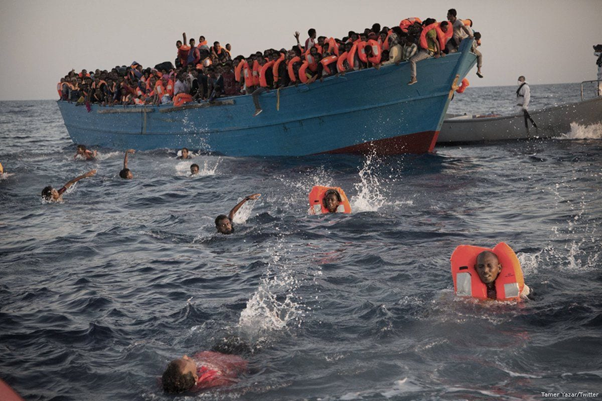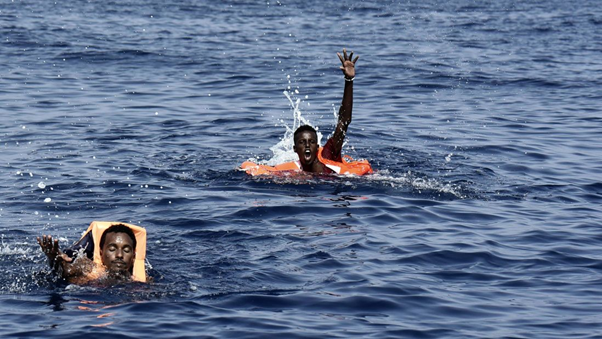All the sufferings of the Black Continent in the last year; From climate change to eternal migration

| The cycle of climate change and the threat of food security and the consequent increase in migration from African countries to other destinations have made the Black Continent face a difficult situation. |
Mehr News Agency, Intergroup International: The two important issues of climate change and migration in Africa are closely related and have practically become two important problems of most African countries. In 1402, we witnessed the continuation of these problems in many countries of the world, and at the same time as the problems of these countries in the field of climate change, which have led to increasing drought and poverty, the number of migration from Africa to Europe and sometimes America has increased.
After the huge floods in South Africa in the Horn of Africa and Somalia in the fall of 1402, we saw heavy losses and damages due to the weather phenomenon known as Nino displaced half a million Somali citizens.
El Niño is a large-scale weather pattern in which precipitation occurs in succession and suddenly affects the world’s climate. This phenomenon occurs with different intensities over a period of two to seven years, and during it, the temperature of the waters of the eastern Pacific Ocean becomes four degrees Celsius warmer than usual, and the rainfall leads to huge floods.
Africa, drought and food security
El Nino caused severe flooding in the eastern parts of Africa, then landslides, increased diseases and food shortages caused great problems in Somalia and At the same time as severe flooding occurred in East Africa, the northern and southern parts of the continent faced severe drought.
Continuous and relentless rain in October brought death, destruction and displacement of people in Somalia, Kenya and Ethiopia, and in 1402, in addition to floods, Droughts and escalating heat waves have also had devastating effects on agriculture, water resources, infrastructure and livelihoods across the African continent. In the last year, many regions of Africa faced water shortages, and this situation aggravates climate change and drought. Irregular rainfall patterns and prolonged droughts have led to water scarcity, and this situation, in addition to negatively impacting Africa’s agriculture and food security, has affected stability, security and public health.
In 1402, we saw a sustained increase in African temperatures, resulting in vulnerable populations being affected by heat-related illnesses. In addition, coastal areas in Africa have become vulnerable to sea level rise, which threatens communities, ecosystems and infrastructure along the coast.
Countries such as Egypt, Nigeria and Senegal are currently witnessing the effects of coastal erosion and salinization of fresh water sources. Climate change has led to the destruction of African ecosystems, including deforestation, desertification, and the loss of biodiversity.
Many African countries are seeking to deal with the consequences of climate change and reviewing the documents and reports of numerous organizations such as the Intergovernmental Panel on Climate Change (IPCC), the Center for Policy The African Climate Commission (ACPC) and the African Development Bank (African Development Bank) show that many African countries in 1402 once again pursued the important issue of “climate resilience and adaptation” and to attract international cooperation. entered into negotiations. But despite the efforts of these countries and attention to initiatives such as the 2063 agenda of the African Union and the renewable energy initiative, there was not much change in their situation.
The connection between climate change and migration
Widespread poverty and lack of access to food resources and welfare is one of the major problems of many African countries, which has caused the migration of citizens of this continent, but in 1402 witnessed The increase in African migration statistics and important factors such as trying to achieve economic opportunities, fleeing political instability and conflict, lack of food security due to climate change, poverty and lack of access to basic services have driven many Africans mainly from different sea routes. Mediterranean, made his way to Europe. The Mediterranean is still a key route for migration from North Africa to Europe, and migrants often embark on dangerous journeys by sea in search of better opportunities, and in 1402, we witnessed numerous accidents and increased human casualties along this route. /p>
Despite the continued movement of African refugees to Europe in 1402, European Union (EU) countries have implemented various migration policies and frameworks to manage migration from Africa and other regions. they did These policies include border control and signing immigration agreements with African countries.
Hans Leitens, the executive director of Frontex, the European Union’s external border protection agency, announced that despite all the strictures and security measures, the complete stop of migration to Europe is not May be. According to statistics, illegal immigration to the EU from West Africa increased more than 10 times in 1402. In a recent year, 380,000 fake passports were obtained from African migrants to enter Europe, and yet more people are still trying to travel to Europe from sub-Saharan African countries. Frontex data in January 2024 showed that the Atlantic Ocean is the busiest route for illegal immigration to the European Union, and UN data shows that in the last year, more than 3,700 migrants have died on the way to Europe. The deadliest events occurred in the Italian coastal town of Staccato di Cotro and the Greek island of Pylos.
The West’s confrontation with African immigrants
The countries of Italy, Spain, Greece, France, Germany and England increased strictness against African immigrants and due to the high number of illegal African immigrants entering Europe, in 1402 we witnessed the adoption of strict decisions and policies by the European Union.
In 1402, Ursula Vander Leyen, the president of the European Commission, presented a 10-point plan to protect Italy against the wave of African immigrants, which is the main basis of its decisions. , trying to quickly return or deport migrants, strengthen borders and fight against human trafficking gangs. In 1402, the highest rate of deportation of African immigrants and their return to their country of origin was recorded, especially in countries such as Guinea, Ivory Coast, Senegal, Burkina Faso, and Tunisia.
In 1402, in addition to Europe, Mexico also witnessed the arrival of illegal African refugees, and the Mexican Ministry of the Interior announced that the number of illegal African immigrants who entered the country compared to the previous year, it increased 9 times and reached 59,834 people from 6,672 people.
In a general assessment, the persistent cycle of climate change and the threat to food security in Africa, the emergence of major problems in the governance of African countries and the consequent increase in illegal immigration, make the conditions It has made it difficult for many countries of the Black Continent, and in the destination countries of immigration, the majority of African immigrants face strict policies and the possibility of deportation or discrimination and exploitation. But the entry gate is kept open to attract African elites and educated people, and in this way, the human resources and scientific expertise sector of the Black Continent countries also faces big problems.





